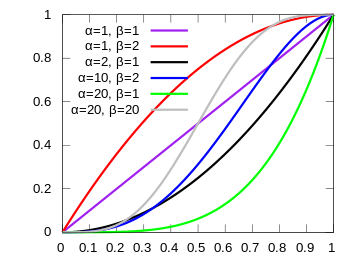Balding–Nichols model
|
Probability density function
| |
|
Cumulative distribution function
| |
| Parameters |
(real) (real) For ease of notation, let , and |
|---|---|
| Support | |
| CDF | |
| Mean | |
| Median | no closed form |
| Mode | |
| Variance | |
| Skewness | |
| MGF | |
| CF | |
In population genetics, the Balding–Nichols model is a statistical description of the allele frequencies in the components of a sub-divided population.[1] With background allele frequency p the allele frequencies, in sub-populations separated by Wright's FST F, are distributed according to independent draws from
where B is the Beta distribution. This distribution has mean p and variance Fp(1 – p).[2]
The model is due to David Balding and Richard Nichols and is widely used in the forensic analysis of DNA profiles and in population models for genetic epidemiology.
References
- ↑ Balding, DJ; Nichols, RA (1995). "A method for quantifying differentiation between populations at multi-allelic loci and its implications for investigating identity and paternity.". Genetica. Springer. 96: 3–12. doi:10.1007/BF01441146. PMID 7607457.
- ↑ Alkes L. Price; Nick J. Patterson; Robert M. Plenge; Michael E. Weinblatt; Nancy A. Shadick; David Reich (2006). "Principal components analysis corrects for stratification in genome-wide association studies" (PDF). Nature Genetics. 38 (8): 904–909. doi:10.1038/ng1847. PMID 16862161.
This article is issued from Wikipedia - version of the 6/26/2016. The text is available under the Creative Commons Attribution/Share Alike but additional terms may apply for the media files.

